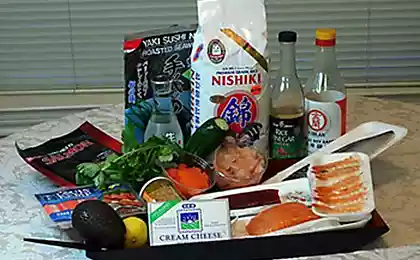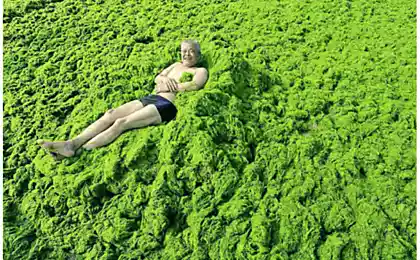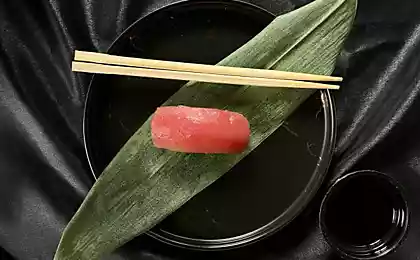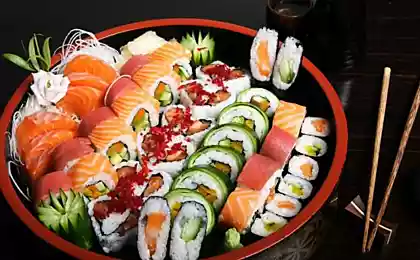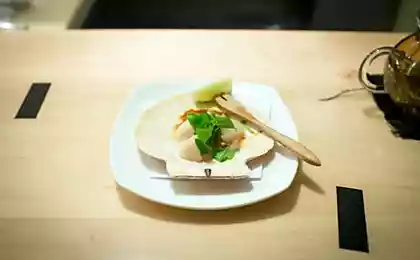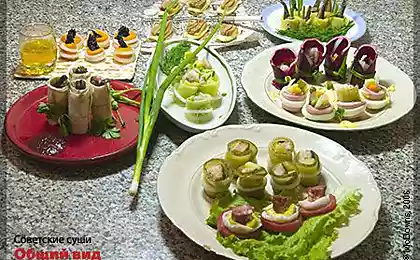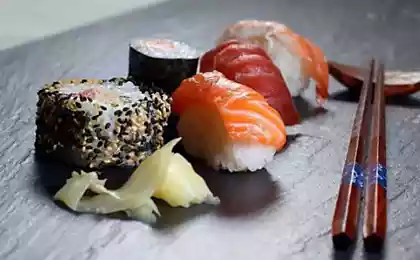571
Dangerous ingredients hidden in 8 popular sushi
Most people believe sushi is a healthy choice when you want to eat at a restaurant, or even just to buy food to take away.
If you order sushi rolls, deep-fried, you probably already know that not everything in the menu of your favorite Asian restaurant is actually useful.
But what may surprise you – even the most conscious in terms of the health sushi lovers - so it is potentially dangerous ingredients hidden in even innocuous dishes such as seaweed salad, wasabi or ginger.

Hazardous ingredients
In the accusatory report Andre Don, the founder of the online NaturallySavvy mentioned many not healthy ingredients popular Asian dishes.
1. The seaweed salad
Algae — excellent source of iodine, vitamins and minerals, provided that they are extracted in pure, not polluted waters. But the seaweed salad sold at many sushi restaurants comes distribyuterskiy companies loose, ready, and may contain:
2. GingerGinger has phenomenal health properties , from relief of nausea and arthritis to promoting heart health and helping in asthma. Unfortunately, the pickled ginger that is typically served with sushi, is often treated with some dangerous additives, including:
3. Bright green Japanese mustard called "wasabi" has anti-inflammatory, antimicrobial, antiplatelet and possibly anti-cancer properties. However, all this refers to real wasabi (i.e., made from the root or rhizomes of the plant wasabia japonica).
Real wasabi is very hard to find even in Japan — it is believed that it serves only 5 percent of restaurants in Japan and in the United States — only restaurants of the highest class.
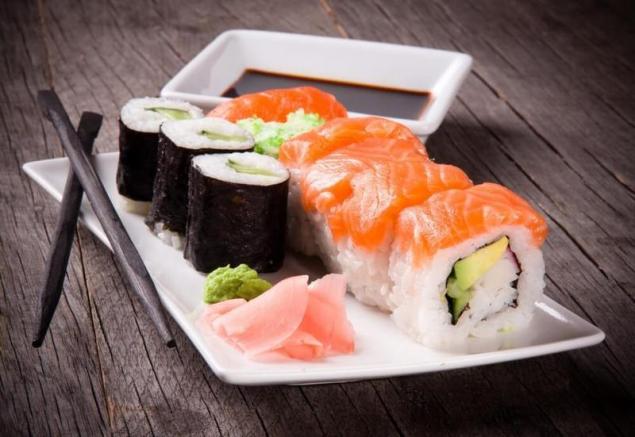
So what are the green paste served with sushi? This is most likely a combination of horseradish, Chinese mustard and green food coloring. Here is what I found in wasabi, the authors of the report:
4. Sesame seeds
Yes... Even sesame seeds can contain hidden ingredients! While most sushi restaurants in your meals add plain toasted sesame seeds and flavored sesame seeds, which contains:
5. Soy sauce
Soy sauce served with sushi, can also contain additives that are best avoided, including:
6. Figure
Rice from which sushi rolls can also contain hidden ingredients designed to make it sweeter. In the above-mentioned report says that rice can contain:
7. Crab sticks
Crab sticks can be made of striped nieper — species of bream, which is under threat of extinction, and that's not all. In them, in addition, may contain additives, including:
8. Flying fish ROE (dried ROE)
In the orange caviar is often served in sushi dishes, often chock-full of the same supplements that and other Asian dishes. Among them:
Sushi of tuna and sea bass — not what you think it isGiven how much is present in many sushi dishes, it becomes apparent that these potentially healthy food have become a victim of artificial additives and fillers, which took the place of real, high-quality ingredients.
But that's not all... When you eat tuna at your favorite sushi restaurant, it is likely that in fact, it's not tuna. Instead, most of the fish labeled "white tuna" may be rovetti (fish oil) is a species of fish that can cause serious digestive disorders, including fatty discharge from the anus (karearea).
The organization Oceana has conducted DNA analysis of more than 1,200 fish samples across the country found that one-third of the names listed incorrectly. Often wrong names are suffering red snapper (87% of samples of "red snapper" actually it was not), followed by tuna (erroneously called 59 per cent).
And in sushi restaurants the misnamed 74 percent of the samples of fish. And these sins every sushi restaurant, which were tested, even in large cities such as Chicago, Austin, new York and Washington.
In many cases, incorrectly named the fish was replaced with cheaper fish, which is less in demand and/or more affordable. More than 90 percent of seafood consumed in the U.S. is imported, but only 1 percent of the import is checked for forgery — and it explains a situation which is clearly out of control.
In sushi tuna tend to have high mercury content
Most of the major waterways of the world are contaminated with mercury, heavy metals and chemical substances such as dioxins, PCBs and other agricultural chemicals which are released into the environment. Fish has always been the best source of omega-3 fats of animal origin EGK and DGK, but with increasing pollution levels, this invaluable and helpful, the food product becomes less viable as a source of healthy fats.
This is especially true for tuna, which becomes the fish with the highest mercury content. According to the results of a study conducted by the U.S. Geological survey, it was found that ALL tuna tested contained a rather large amount of mercury. Even higher contamination of tuna in restaurants, which, again, confirms to order tuna in a restaurant — he was still a risk.
In addition, according to a separate study, Toxicological analyses revealed that tuna sold in restaurants actually contains more mercury than tuna bought in the store. The reason is that restaurants tend to prefer such kinds of tuna, blue akami and bigeye tuna, and much higher mercury content than in the blue and yellowfin. Unfortunately, the mercury, as a rule, largely accumulates in muscles than in fat, because of what this valuable, low-fat fish more susceptible to high levels of pollution.
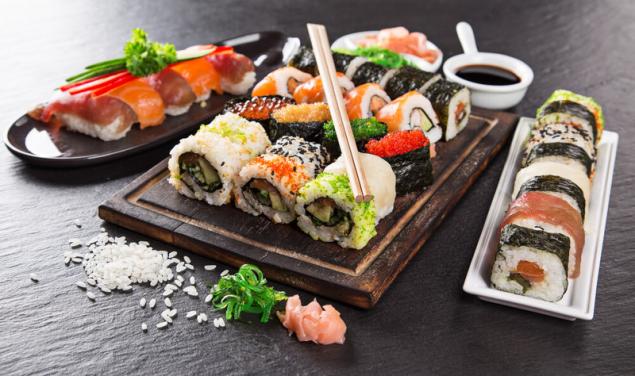
No longer do you have a favorite sushi?If you love sushi and want to enjoy them without any health risks, try to cook them at home. Buy a whole fish with low mercury content, such as caught in the wild Alaskan sockeye salmon, and use natural ginger and wasabi for condiments.
The eyes are afraid — hands do! There are plenty of online tutorials about how to prepare sushi at home.
In addition, whenever I consume fish, and are sure to take Chlorella pills. Effective Chlorella binds to mercury and if you eat it with fish, it will bind the mercury before this metal will be absorbed by the organism — subsequently, the mercury is excreted in the stool.
If you want to eat at a restaurant, look for a better school, to prepare themselves, for example, the same seaweed salad and you will be confident in the ingredients of their dishes. Stay away from tuna because of mercury — give preference to wild-caught wild salmon is low in mercury content and think about how to take natural wasabi and pickled ginger (you can buy them in health food stores).
You can also try a fully vegetarian sushi and give up seafood, if their types and purity cause you to doubt.
Definitely avoid any sushi made from grown in rybhoznaya fish. Remember that fish farming is the aquatic version of growing in restricted content, and exactly the same as on farms and poultry farms on land, fish from fish farms are exposed to many diseases due to crowding too large quantities in a small space.
In addition, they produce toxic waste, and the fish in them are of lower quality. This fish is also polluted with drugs and feed from genetically modified corn and soybean meal, and in the case of salmon, synthetic astaxanthin, produced from petrochemicals, not approved for human consumption.
P. S. And remember, only by changing their consumption — together we change the world! ©
Source: russian.mercola.com/sites/articles/archive/2017/03/06/%D0%B8%D0%BD%D0%B3%D1%80%D0%B5%D0%B4%D0%B8%D0%B5%D0%BD%D1%82%D1%8B-%D1%81%D1%83%D1%88%D0%B8.aspx
If you order sushi rolls, deep-fried, you probably already know that not everything in the menu of your favorite Asian restaurant is actually useful.
But what may surprise you – even the most conscious in terms of the health sushi lovers - so it is potentially dangerous ingredients hidden in even innocuous dishes such as seaweed salad, wasabi or ginger.

Hazardous ingredients
In the accusatory report Andre Don, the founder of the online NaturallySavvy mentioned many not healthy ingredients popular Asian dishes.
1. The seaweed salad
Algae — excellent source of iodine, vitamins and minerals, provided that they are extracted in pure, not polluted waters. But the seaweed salad sold at many sushi restaurants comes distribyuterskiy companies loose, ready, and may contain:
- Corn syrup with high fructose.
- Vegetable oil.
- Hydrolyzed protein (contains monosodium glutamate or MSG).
- Artificial dyes such as yellow No. 4 and blue No. 1.
- Genetically modified (GM) ingredients.
2. GingerGinger has phenomenal health properties , from relief of nausea and arthritis to promoting heart health and helping in asthma. Unfortunately, the pickled ginger that is typically served with sushi, is often treated with some dangerous additives, including:
- The monosodium approved for sodium.
- Aspartame.
- Potassium sorbate (preservative).
- Artificial dyes including red # 40, which is associated with hyperactivity in children (if the ginger pink).
3. Bright green Japanese mustard called "wasabi" has anti-inflammatory, antimicrobial, antiplatelet and possibly anti-cancer properties. However, all this refers to real wasabi (i.e., made from the root or rhizomes of the plant wasabia japonica).
Real wasabi is very hard to find even in Japan — it is believed that it serves only 5 percent of restaurants in Japan and in the United States — only restaurants of the highest class.

So what are the green paste served with sushi? This is most likely a combination of horseradish, Chinese mustard and green food coloring. Here is what I found in wasabi, the authors of the report:
- Artificial flavors.
- Artificial dyes.
- Potential GM ingredients (corn and soy).
4. Sesame seeds
Yes... Even sesame seeds can contain hidden ingredients! While most sushi restaurants in your meals add plain toasted sesame seeds and flavored sesame seeds, which contains:
- Artificial dyes.
- Artificial sweeteners (Sucralose).
5. Soy sauce
Soy sauce served with sushi, can also contain additives that are best avoided, including:
- Hydrolyzed soy protein (MSG).
- GM ingredients (soya and maize).
- Corn syrup.
- Potassium sorbate (preservative).
- Burnt sugar (some species may form potentially carcinogenic byproducts).
6. Figure
Rice from which sushi rolls can also contain hidden ingredients designed to make it sweeter. In the above-mentioned report says that rice can contain:
- Corn syrup with high fructose.
- Aspartame.
7. Crab sticks
Crab sticks can be made of striped nieper — species of bream, which is under threat of extinction, and that's not all. In them, in addition, may contain additives, including:
- The monosodium approved for sodium.
- Artificial flavors.
8. Flying fish ROE (dried ROE)
In the orange caviar is often served in sushi dishes, often chock-full of the same supplements that and other Asian dishes. Among them:
- The monosodium approved for sodium.
- Corn syrup with high fructose.
- Artificial coloring (yellow No. 6).
Sushi of tuna and sea bass — not what you think it isGiven how much is present in many sushi dishes, it becomes apparent that these potentially healthy food have become a victim of artificial additives and fillers, which took the place of real, high-quality ingredients.
But that's not all... When you eat tuna at your favorite sushi restaurant, it is likely that in fact, it's not tuna. Instead, most of the fish labeled "white tuna" may be rovetti (fish oil) is a species of fish that can cause serious digestive disorders, including fatty discharge from the anus (karearea).
The organization Oceana has conducted DNA analysis of more than 1,200 fish samples across the country found that one-third of the names listed incorrectly. Often wrong names are suffering red snapper (87% of samples of "red snapper" actually it was not), followed by tuna (erroneously called 59 per cent).
And in sushi restaurants the misnamed 74 percent of the samples of fish. And these sins every sushi restaurant, which were tested, even in large cities such as Chicago, Austin, new York and Washington.
In many cases, incorrectly named the fish was replaced with cheaper fish, which is less in demand and/or more affordable. More than 90 percent of seafood consumed in the U.S. is imported, but only 1 percent of the import is checked for forgery — and it explains a situation which is clearly out of control.
In sushi tuna tend to have high mercury content
Most of the major waterways of the world are contaminated with mercury, heavy metals and chemical substances such as dioxins, PCBs and other agricultural chemicals which are released into the environment. Fish has always been the best source of omega-3 fats of animal origin EGK and DGK, but with increasing pollution levels, this invaluable and helpful, the food product becomes less viable as a source of healthy fats.
This is especially true for tuna, which becomes the fish with the highest mercury content. According to the results of a study conducted by the U.S. Geological survey, it was found that ALL tuna tested contained a rather large amount of mercury. Even higher contamination of tuna in restaurants, which, again, confirms to order tuna in a restaurant — he was still a risk.
In addition, according to a separate study, Toxicological analyses revealed that tuna sold in restaurants actually contains more mercury than tuna bought in the store. The reason is that restaurants tend to prefer such kinds of tuna, blue akami and bigeye tuna, and much higher mercury content than in the blue and yellowfin. Unfortunately, the mercury, as a rule, largely accumulates in muscles than in fat, because of what this valuable, low-fat fish more susceptible to high levels of pollution.

No longer do you have a favorite sushi?If you love sushi and want to enjoy them without any health risks, try to cook them at home. Buy a whole fish with low mercury content, such as caught in the wild Alaskan sockeye salmon, and use natural ginger and wasabi for condiments.
The eyes are afraid — hands do! There are plenty of online tutorials about how to prepare sushi at home.
In addition, whenever I consume fish, and are sure to take Chlorella pills. Effective Chlorella binds to mercury and if you eat it with fish, it will bind the mercury before this metal will be absorbed by the organism — subsequently, the mercury is excreted in the stool.
If you want to eat at a restaurant, look for a better school, to prepare themselves, for example, the same seaweed salad and you will be confident in the ingredients of their dishes. Stay away from tuna because of mercury — give preference to wild-caught wild salmon is low in mercury content and think about how to take natural wasabi and pickled ginger (you can buy them in health food stores).
You can also try a fully vegetarian sushi and give up seafood, if their types and purity cause you to doubt.
Definitely avoid any sushi made from grown in rybhoznaya fish. Remember that fish farming is the aquatic version of growing in restricted content, and exactly the same as on farms and poultry farms on land, fish from fish farms are exposed to many diseases due to crowding too large quantities in a small space.
In addition, they produce toxic waste, and the fish in them are of lower quality. This fish is also polluted with drugs and feed from genetically modified corn and soybean meal, and in the case of salmon, synthetic astaxanthin, produced from petrochemicals, not approved for human consumption.
P. S. And remember, only by changing their consumption — together we change the world! ©
Source: russian.mercola.com/sites/articles/archive/2017/03/06/%D0%B8%D0%BD%D0%B3%D1%80%D0%B5%D0%B4%D0%B8%D0%B5%D0%BD%D1%82%D1%8B-%D1%81%D1%83%D1%88%D0%B8.aspx
4 exercises for stretching the spine and increasing elasticity of ligaments
Urn tetraBIN makes the disposal of garbage in the game
